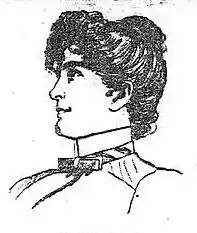1902 Ontario general election
The 1902 Ontario general election was the tenth general election held in the Province of Ontario, Canada. It was held on May 29, 1902, to elect the 98 Members of the 10th Legislative Assembly of Ontario ("MLAs").[1]
| |||||||||||||||||||||||||
98 seats in the 10th Legislative Assembly of Ontario 50 seats were needed for a majority | |||||||||||||||||||||||||
|---|---|---|---|---|---|---|---|---|---|---|---|---|---|---|---|---|---|---|---|---|---|---|---|---|---|
| |||||||||||||||||||||||||
| |||||||||||||||||||||||||
The Ontario Liberal Party, led by Sir George William Ross, formed the government for a ninth consecutive term, although with only a very slim, two-seat majority in the Legislature.
The Ontario Conservative Party, led by Sir James P. Whitney formed the official opposition.
Expansion of the Legislative Assembly
The number of electoral districts was increased from 93 to 97, under an Act passed in 1902. Ottawa in both cases was entitled to elect two members, and thus 98 MLAs would now be elected to the Legislature.[2] The following electoral changes were made:
- Algoma West was divided into Fort William and Lake of the Woods and Port Arthur and Rainy River
- Algoma East was divided into Algoma, Manitoulin and Sault Ste. Marie
- Nipissing was divided into Nipissing East and Nipissing West
Results
| Political party | Party leader | MPPs | Votes | |||||||
|---|---|---|---|---|---|---|---|---|---|---|
| Candidates | 1898 | Dissol. | 1902 | ± | # | % | ± (pp) | |||
| Liberal | George William Ross | 94 | 51 | 50 | 1 |
206,709 | 47.54% | 0.25 | ||
| Conservative | James P. Whitney | 97 | 42 | 48 | 6 |
215,883 | 49.65% | 1.96 | ||
| Independent-Conservative | 2 | 1 | – | 1 |
1,646 | 0.38% | 0.03 | |||
| Independent | 4 | – | – | – | 5,133 | 1.18% | 3.42 | |||
| Prohibitionist | 6 | – | – | – | 3,126 | 0.72% | New | |||
| Socialist | 9 | – | – | – | 1,993 | 0.46% | New | |||
| Socialist-Labour | 4 | – | – | – | 277 | 0.06% | New | |||
| Labour | 1 | – | – | – | Did not campaign | |||||
| Vacant | ||||||||||
| Total | 216 | 94 | 94 | 98 | 434,767 | 100.00% | ||||
| Blank and invalid ballots | 4,021 | |||||||||
| Registered voters / turnout | 588,570 | 74.55% | 7.50 | |||||||
| Party | Seats | Votes | Change (pp) | |||
|---|---|---|---|---|---|---|
| Liberal | 50 / 94 | 47.54% | 0.25 | |||
| Conservative | 48 / 94 | 49.65% | 1.96 | |||
| Other | 0 / 94 | 2.81% | -2.21 | |||
Division of ridings

The newly created ridings returned the following MLAs:
| 1898 | 1902 | ||||
|---|---|---|---|---|---|
| Riding | Party | Riding | Party | ||
| Algoma West | █ Liberal | Fort William and Lake of the Woods | █ Liberal | ||
| Port Arthur and Rainy River | █ Liberal | ||||
| Algoma East | █ Liberal | Algoma | █ Conservative | ||
| Manitoulin | █ Conservative | ||||
| Sault Ste. Marie | █ Conservative | ||||
| Nipissing | █ Liberal | Nipissing East | █ Liberal | ||
| Nipissing West | █ Liberal | ||||
Seats that changed hands
| Party | 1898 | Gain from (loss to) | 1902 | ||||||
|---|---|---|---|---|---|---|---|---|---|
| Lib | Con | I-Con | |||||||
| Liberal | 48 | 10 | (12) | 46 | |||||
| Conservative | 42 | 12 | (10) | 1 | 45 | ||||
| Independent-Conservative | 1 | (1) | – | ||||||
| Total | 91 | 12 | (10) | 10 | (13) | 1 | – | 91 | |
Of the constituencies that were not altered, there were 23 seats that changed allegiance in the election:
|
|
Notable candidates

Margaret Haile, a Canadian Socialist League candidate in Toronto North, made history as the first woman ever to run for political office in Canada.[3]
See also
References
- "1902 General Election". Elections Ontario. Elections Ontario. Retrieved January 3, 2021.
- An Act respecting the Representation of the People in the Legislative Assembly, R.S.O. 1897, c. 6 , as amended by An Act to amend the Act respecting the Representation of the People in the Legislative Assembly, S.O. 1902, c. 4
- Janice Newton, The feminist challenge to the Canadian Left, 1900-1918.
Further reading
- Hopkins, J. Castell (1903). The Canadian Annual Review of Public Affairs, 1902. Toronto: The Annual Review Publishing Company.
.jpg.webp)
